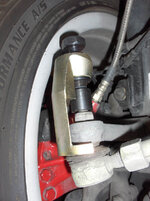Glad you found the culprit! The idler arm is #8 in the EPC diagram (attached below). This is what the tie rod & drag link attach to on the passenger side (on the driver side, they attach to the steering gearbox Pitman arm).
Click here for the HOW-TO on checking the idler arm bushings for play. If there is excess play, the idler arm bushing kit (#14) is NLA but you can order the bushings separately, p/n
129-463-00-50, qty = 2. They are $59 each, ~$45 discount, but may be special order from Germany - most RevParts dealers are showing these as "Currently Unavailable", which is code for "we don't have these in stock in USA".
R&R of tie rod ends & drag link ends is generally not fun. Try to use tools similar to the one shown in the attached photos. Pickle forks do not work well. The drag links tend to be the difficult ones because there isn't space for conventional separation tools, and the factory tool is crazy expensive.
Alignment - if there's an MB dealership near you, call them for a price. Up to around $200 is reasonable-ish today for a dealer alignment. My local dealer wants $300 which I refuse to pay. I found a local indy shop that is only $160. Alternately you can buy a
Gyraline kit which claims to work fairly well.
Set the new tie rod assembly lengths as close to the old ones as possible. Even so the toe will be WAY off initially. Use a tape measure across the tire treads, front and rear, as high as you can get towards center. As a rough setting, adjust to zero to about 1/8" toe-
in (front of tires closer together vs rear of tire). This measurement will change depending if the wheels are in the air, or on the ground. The measurement on the ground is more critical. Adjusting is a PITA since you need to jack the car up each time (or, raise it on a lift each time). You can measure this before starting to get an idea what the current toe is via tape measure... if you do this, measure both on the ground (before lifting the car), and again with the wheels in the air. Having a second person is very helpful.











